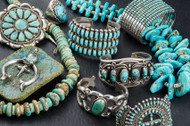Turquoise: Ancient Stone with Modern Appeal
Jul 5th 2019
 Something magical happens in a very few places on earth. When highly acidic water laden with copper seeps into the ground and reacts with a select group of minerals over many, many years, an opaque, brilliant blue stone is formed. As many as 6,000 years ago, ancient Egyptians made jewelry from this stone, and its color that calls to mind sea and sky was revered all over the world, wherever the stone was found or traded for other valuable commodities.
Something magical happens in a very few places on earth. When highly acidic water laden with copper seeps into the ground and reacts with a select group of minerals over many, many years, an opaque, brilliant blue stone is formed. As many as 6,000 years ago, ancient Egyptians made jewelry from this stone, and its color that calls to mind sea and sky was revered all over the world, wherever the stone was found or traded for other valuable commodities.
The dry lands of the Southwestern Unites States have ideal conditions for the creation of turquoise, and the mines in Arizona, New Mexico, and Colorado produce a variety of hues of turquoise valued all over the world.
Ancient and modern Native American cultured revered the stone, and some of the most prized artisan jewelry is created using the classic combination of sterling silver and turquoise. Whether we—like the Navaho—associate the stone with happiness, luck, and wealth, or we simply covet the stone for its cheerful hue, turquoise is a fascinating stone.
History and Sources
In parched deserts, some Native Americans believed that, performing rain dances would bring life-giving water. When the rains began, the tears of joy wept by the People mixed with the rain, seeped into the earth, and became the Sky Stone. The Apache believed a piece of turquoise on a bow or a gun would improve the weapon's accuracy. Other Native Americans believed turquoise offered protection to its wearer, and if a stone cracked, it was because "the stone took it," meaning turquoise took a blow that would otherwise have fallen on the wearer.
Turquoise varies enormously in terms of color, hardness, and the veins of other materials (like pyrite) that run throughout, and every individual mine produces unique stones, identifiable sometimes just by a visual inspection and certainly by chemical analysis.
It is the wide and unique variability of turquoise that lets us know, turquoise was widely traded throughout the Americas as far back as the Anasazi civilization that flourished from 350 BC until 1450 AD. Turquoise mined by the Anasazi in what we now know as the famed Cerillos Mine in New Mexico has been found in areas of Mexico that were populated by the Aztecs. It was also discovered at Chichen Itza on Mexico's Yucatan Peninsula, and archaeologists have found turquoise stones mined by the Anasazi in Chaco Canyon, New Mexico.
Some of the most famous mines in the Southwest are:
- Cerillos. Located in New Mexico's Burro Mountains, stones from Cerillos are prized for their hardness and ability to take and hold polishing. The stones vary widely in color, from white, to khaki, to green, and blue. Cerillos also has the distinction of being the oldest mine in North America.
- Kingman. Located near Kingman, Arizona, this mine is one of the largest domestic turquoise mines and produces a large volume of high-quality stones in hues of light-to-dark blue, some with tints of green, and others with flecks of pyrite and quartz.
- Sleeping Beauty. Located near Globe, Arizona, stones from this mine are valued for their clear, sky-blue color with very little veining.
Turquoise mining produces an astonishing spectrum of colors, some of which have veins or other colors running throughout—what gemologists call the "matrix" of turquoise. Though some famous mines are no longer operational, their stones have great historical and collectible value.
Turquoise Treatment
Turquoise is most often found in veins, though nuggets occur as well. The Mohs scale used by mineralogists to express the relative hardness of stones rates turquoise anywhere from 2-6. For comparison, a diamond on the Mohs scale is a 10, while talc is a 1. Gem quality natural turquoise comes in around 5-6.
So much turquoise is too soft to cut and polish with any expectation of longevity, but that doesn't mean the softer stones can't be useful. In fact, natural gem quality turquoise is pretty rare, so a range of treatments have been developed. Reputable stone dealers will always disclose any treatments and clearly label stones.
Here are some you will encounter:
- Natural. These rare, untreated stones are simply cut and polished. They remain a bit porous and will likely change color (typically deeper) as they're worn.
- Stabilized. This turquoise is chemically treated to harden the stones and make them more durable. Most commercially available turquoise is stabilized with resin, though a number of other methods exist.
- Color-treated. These stones are dyed to enhance the blue color and stabilized.
- Reconstituted. This turquoise is created by grinding small, softer pieces of turquoise, mixing the powder with resin, and reforming it to create new stones.
- Simulated/Imitation. Simulated turquoise can either be lower-quality stones dyed to look like turquoise or pieces made entirely of plastic.
Don't be afraid to ask questions about the origin or treatment of stones you're considering. Good jewelers and dealers will be prepared to answer your questions.
Wearing turquoise connects you to a long tradition—one that dates back thousands of years and spans the globe. Choosing a stone mined in the Southwest and placed into artisan jewelry created there honors the long Native American tradition of cherishing this lovely sky-blue stone.

